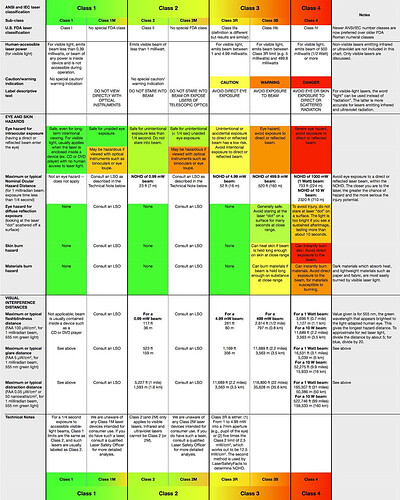The problem, to my understanding, is the class is set by the manufacturing. The Basic is Class 1, in part, because the body being, itself, the enclosure. With the pass-through, there is not way to make the Pro into a “Class 1”, though I am also considering options for making a Class 1 enclosure that it can fit inside. I’d still have to get that enclosure rated as a Class 1, and it wouldn’t change the fact that the Pro is permanently a Class 4 laser.
Right, but my understanding is that if you take a Class 4 laser and put it in a Class 1 enclosure, you have a Class 1 system. That’s essentially what the Basic is (Class 4 laser tube in a Class 1 enclosure.) So if you take a Pro and put it into a certified Class 1 enclosure (with the interlocks hooked up and functional) then you have a Class 1 system you could demo at trade shows, use in schools, etc. But I’m not an expert!
I was thinking along the same lines, but it would still require having the enclosure you make for the Pro certified Class 1. I know I have seen rumors of  looking into doing something to allow operation of the Pro in more normal Class 1 circumstances, but it was VERY low detail giving room for a lot of speculation. If I was building my own, it would probably have to force the lid open if the door was opened, and it would have to have some kind of pass-thru for pressing the button. The other big option would be completely cutting power when opened. Even a framed, glass container would clearly show the safeties for that. Of course, I’m mostly considering for additional safety in my own home, not so much the intent for showing elsewhere. I wanted the Pro features, but I do want to operate it as safely as possible.
looking into doing something to allow operation of the Pro in more normal Class 1 circumstances, but it was VERY low detail giving room for a lot of speculation. If I was building my own, it would probably have to force the lid open if the door was opened, and it would have to have some kind of pass-thru for pressing the button. The other big option would be completely cutting power when opened. Even a framed, glass container would clearly show the safeties for that. Of course, I’m mostly considering for additional safety in my own home, not so much the intent for showing elsewhere. I wanted the Pro features, but I do want to operate it as safely as possible.
Yes putting it inside another case with interlocks could make it class 1 if the case was certified but in practice it is complete overkill. Putting aluminium strips over the inside of the pass through slot would make it just as safe as a basic but without certification. If you took it for certification I expect it would pass as long as it needed tools to remove them.
If I were GF I would have I would have put lockable covers on the inside with interlocks where the lock also activates a moving digit on a certification plate that switches it from class 4 to class 1. I would then have campaigned for a dual certification.
Also, here’s the industry Class 4 ![]() factsheet. This is NOT a Glowforge safety fact sheet.
factsheet. This is NOT a Glowforge safety fact sheet.
In other news, if I ever decide to dismantle my Glowforge and start lasing the sky with it, the FAA is going to be pissed for miles around. Flash blindness at 3.5km for 10W of power?
The site had a really good breakout of the Classing of Lasers.
I can follow the the design risks (Class 1 rating with Basic versus Class 4 rating with Pro) because the manufacture of a product preventing any possibility of laser light escaping (when used as designed) makes the Class 4 laser rated beam (measured by it output power) a Class 1 rated assembled product (the GF  Basic model).
Basic model).
Here is the Laser Classes PDF and here if it is easier:
Spreadsheet—laser-classes.pdf (57.8 KB)
That is for Green. They say Red is 1/5th that, but 1/20th.
With Glowforge, and a CO2 laser being technically on the invisible spectrum, if I recall correctly, the concern would be direct retinal damage rather than flash blindness. FAA would still be pissed for miles around. 45W CO2 can do a lot worse than flash blindness or visible light distraction.
I better keep my shades drawn while operating my GF, I live less than 2 miles from the airport and sometimes feel I can reach out and touch the planes as they go over. I’d hate to inadvertently take one down because the laser bounced out my pass through slot… 







Your post was probably flagged on an NSA computer somewhere that data mines the internet for certain keyword combinations. 
The eye is opaque to far IR, so it will burn the surface, not the retina. There are videos showing it instantly damages the surface of the cornea. It would take a long time to burn all the way to the retina if at all.
Visible lasers are dangerous at lower powers because they get focused onto the retina, so it doesn’t take much power at all to damage it.
Ah, learn something new.
So no engraving gremlins on the bottom of wings as planes fly overhead…?
If you can build a system that can laser-engrave something recognizable on the underside of a plane as it flies past… I think the government has a job for you!
Indeed. Start laser engraving enemy warplanes.
It was the nature of the damage to the eye for non-visible laser that was new learning for me. I’ve got laser glasses either way.
CO2 lasers are far IR, 10.6um. I have some IR laser diodes that are near IR, 808nm. I.e. just below red visible light. They would burn the retina because near IR behaves much the same as visible light and passes through transparent objects like the eye lens, glass, acrylic, etc. And because it is invisible it makes them more dangerous than visible lasers.
I have different laser googles for those and also a pair for blue laser light. It gets very expensive playing with class 4 lasers.
Too true. So far, I only have to have safety for CO2 laser. Future? Who knows.
i’m fiddling with a 4w diode; need to do something with this garbage plotter kit i bought once upon a time. i’ve been wondering how expensive it would be to create a box of laser-blocking material (like those sound dampeners over high-powered blenders at starbucks) with a hinge that i could open, or if it’s light enough just pick up.
I always planned to make a DiBond screen around HydraRaptor when experimenting with lasers and just view it with a camera. DiBond has a 0.3mm aluminium skin that will block all but very high power direct beam strikes.
Now I am finally getting around to experimenting with laser diodes I have bought an expensive pair of goggles for the relevant frequencies. I might still use a camera because the laser light is invisible but should show up on an RPI noir camera.
